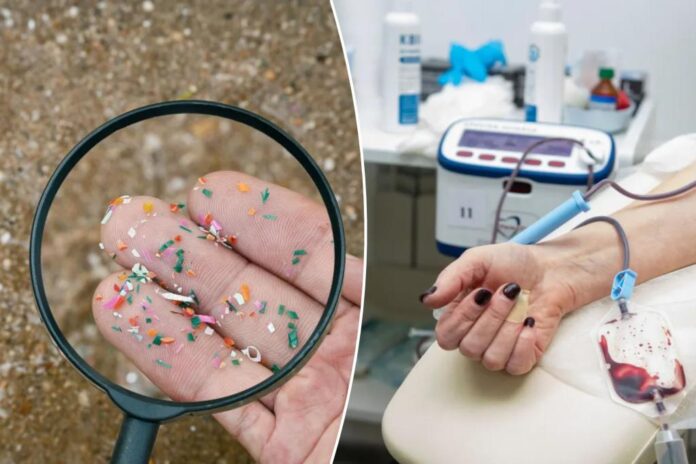They’re small, sneaky and swimming in your veins.
Microplastics have been found throughout the human body — and early research suggests they may pose some serious health risks.
Now, scientists say a blood-filtration technique already used in hospitals around the world might be able help flush them out.
The procedure, known as therapeutic apheresis, filters blood through a specialized machine. It removes abnormal proteins, unhealthy cells and other harmful substances, then pumps the cleaned blood back into the body.
Therapeutic apheresis is already used to treat everything from autoimmune diseases and blood disorders to neurological issues, long covid and some cancers.
It can filter out particles as small as 200 nanometers — about 5,000 times smaller than a millimeter.
That’s well within the range of microplastics, which are defined as plastic fragments smaller than 5 millimeters.
In a new study out of Germany, scientists treated 21 patients with chronic fatigue syndrome using two rounds of therapeutic apheresis — essentially, a double filter.
Afterward, they analyzed the waste fluid that had been separated from the patients’ blood.
The researchers found substances with the chemical signatures of polyamide and polyurethane, two plastics commonly used in industrial manufacturing.
The findings suggest the plastic particles may have been successfully removed during treatment — though more research is needed to verify the results.
The study didn’t measure how much plastic was removed or compare before-and-after levels. Further testing is also needed to confirm the exact identity of the materials detected in the waste.
Still, researchers say the early results are encouraging and are calling for larger studies to see how effective the technique really is in scrubbing microplastics from the bloodstream.
But some high-end private practices aren’t waiting to find out.
In London, Clarify Clinic is already offering blood-cleansing treatments aimed at removing microplastics, forever chemicals and other toxins with treatments starting at $12,636.
“Once it’s running, you feel nothing. It’s very comfortable,” CEO Yael Cohen told Wired. “Patients take calls, do Zooms, watch movies, sleep.”
Cohen said people seek out the treatment for all kinds of reasons, including some who are worried about the long-term effects of microplastics in their bodies.
“I think it’s a badge of honor to be doing your future self a favor,” she said.
What are microplastics — and why are they in your body?
Microplastics are tiny plastic fragments that break off from everyday items, like packaging, bottles, synthetic fabrics and industrial waste.
They’ve been detected in the food we eat, the water we drink, and even the air we breathe.
Researchers have also found the pesky particles throughout the human body, including in the lungs, livers, kidneys, hearts, brains, placentas and testicles, as well as in breast milk and semen.
While scientists are still studying the full impact of microplastics on human health, early findings have raised some red flags.
A major scientific review published in January found that microplastic exposure may harm the digestive, reproductive and respiratory systems.
Other studies suggest possible links to heart attacks, strokes and other cardiovascular problems.
Microplastics have also been shown to trigger inflammation and oxidative stress, which can lead to cell damage and may contribute to a wide range of health problems, including metabolic disorders, immune dysfunction and even cancer.
Additionally, there’s growing evidence the particles may cause neurological symptoms like fatigue and dizziness. Higher concentrations have also been observed in people with dementia.
To make matters worse, microplastics may also affect your skin.
Over time, exposure is thought to potentially cause dryness, redness, irritation and even signs of premature aging like fine lines and wrinkles.








